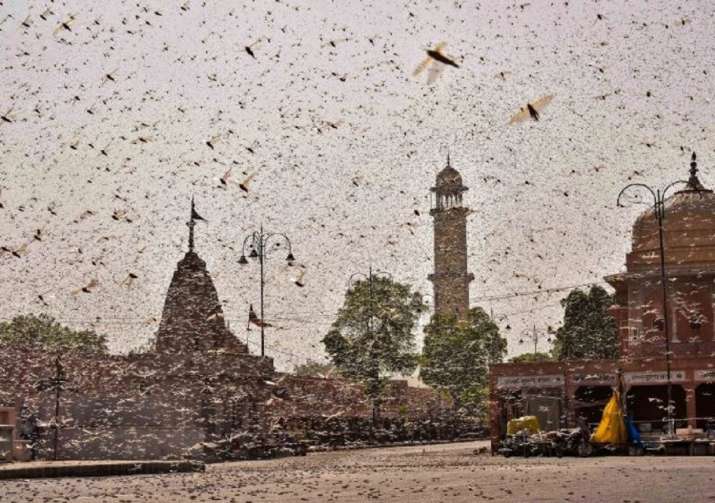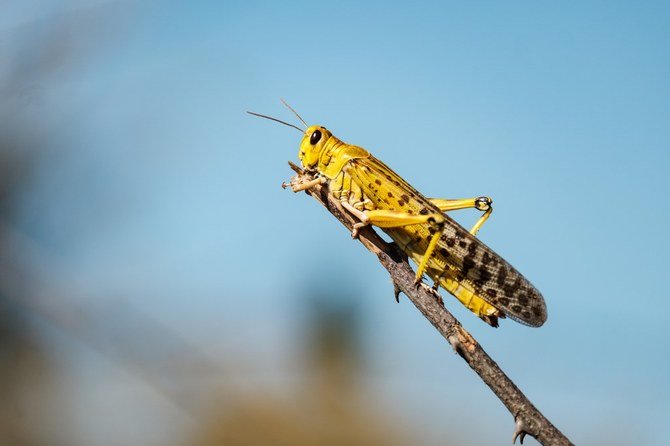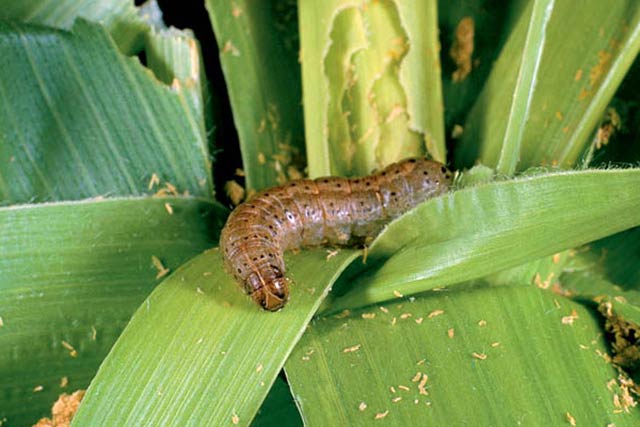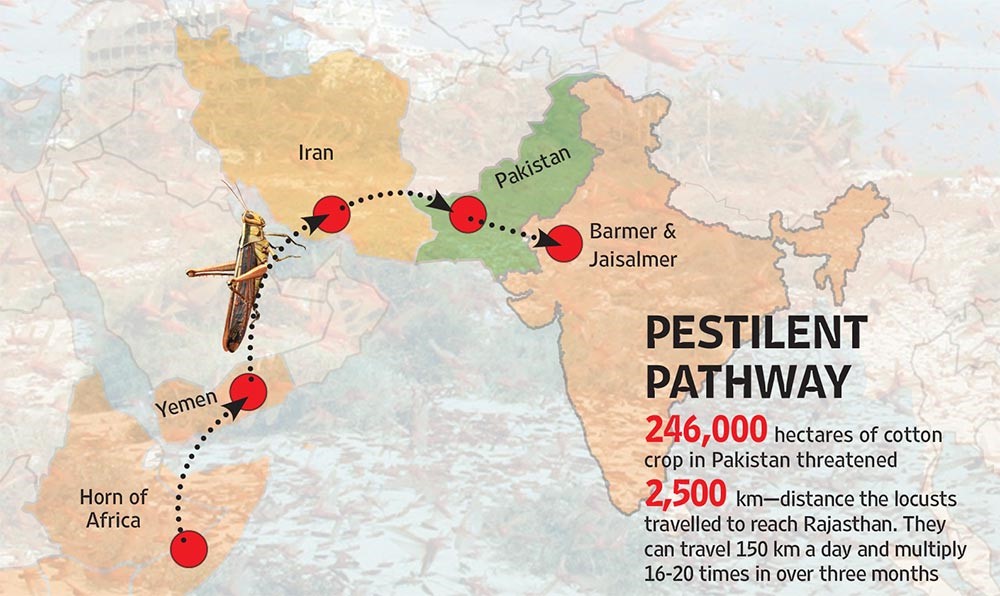Locust Attacks
2020 MAY 23
Mains >
Agriculture > Crops > Agri productivity

IN NEWS:
Amid the coronavirus pandemic, India is bracing for the worst locust attack in the past three decades.
PESTS:
- A pest is any animal or plant which has a harmful effect on humans, their food or their living conditions. Pest attacks on large scale are often considered a biological disaster.
- Locusts and fall armyworms are the most threatening pests found in the Indian subcontinent.
I. Locust:
- Locusts are short-horned grasshoppers that belong to the family Acrididae. They migrate over large distances in swarms and eat voraciously on green, leafy plants. When conditions are favorable for reproduction, locust numbers increase 20-fold in three months.
- Usually, it restricts itself to the semi-arid and arid deserts of Africa and West Asia. In the current case, these pests entering from Pakistan had damaged standing crops. Apart from India, the pests have attacked 60 countries in two major continents. Pakistan and Somalia had to declare emergencies to control the pests.
- Desert or yellow locusts have already raided several districts in Rajasthan and Gujarat.

II. Fall Army Worm (FAW):
- A native of America, the FAW was globally first spotted elsewhere in Africa. Now over 50 countries are affected by it, including India.
- It is the caterpillar of a moth variety. It is a rapid breeder and has wide adaptability to harsh conditions. Because of its ability to fly over 100 kms a night, it spreads quickly to adjacent areas.
- The damage caused by the worm is colossal as it has 30-40 days life cycle and one moth can lay upto 1000 eggs at a time.
- In India, first spotted in Shimoga district of Karnataka. Now it has spread to 10 states. It has mostly affected maize crops, but has also been reported to affect paddy, sugarcane and sweet corn.

CURRENT LOCUST ATTACKS:
- India has witnessed several pest attacks in the recent years. In the present attack, locusts flew in from Pakistan and wreaked havoc in 18 districts of Rajasthan and 12 districts of Madhya Pradesh. New swarms bred in the Horn of Africa and parts of the Arabian Peninsula are likely to move towards India soon.
- Heavy rainfall in the counties like Yemen, Djibouti, Ethiopia, Kenya, Iran and Afghanistan have helped in the breeding of the locusts. Favourable climatic conditions have resulted in their multiplication that is 400 times more than usual.
- The locusts are currently active in Rajasthan, Gujarat, Maharashtra, Uttar Pradesh, Haryana, Punjab and Madhya Pradesh. Desert locusts have engulfed around 35,000 hectares in seven of India’s states, threatening some vegetable and pulse crops.
- The wind patterns may take the swarm of locusts towards Delhi. With 22% of its area under green cover, Delhi could be severely impacted by the locust attacks.

REASONS:
- Commercial agriculture: Large scale intensive monoculture of crops has led to exponential rise in the population of pests that feed on them. The introduction of new crop varieties and alien faunal varieties often aggravates pest attacks. For e.g.: The African catfish was introduced in India for aquaculture, but has become a major pest. Due to the threat it poses to the ecosystem, the government prohibited its culture, but it continues to infest inland water bodies in states like Andhra Pradesh and Kerala.
- Irrational use of chemical inputs: Indiscriminate use of pesticides leads to destruction of natural enemies and rise of pesticide resistant varieties. Also, Pests such as blight uses atmospheric nitrogen for their metabolism. The increased use of nitrogen-based fertilizers has createed better conditions for their infestation. Besides these, pesticide market in India has a fair share of spurious products.
- Poor phytosanitary regulation: The poor screening and inspection of imported food crops leads to introduction of alien invasive species into the country. Eg: The FAW is believed to have reached India through Agri imports from Africa. Within the country, poor post-harvest crop management leads to the rapid spread of pests across the country.
- Climate change: Climate change induces variations in precipitation patterns. This has altered the microclimates of areas, thus making them ideal for pests. For e.g.: Climate change-induced unseasonal rains have been considered to be the main reasons for the present locust infestation.
- Fragmented knowledge network: In India, the link between researchers and farmers is wide and highly fragmented. Illiterate farmers fail to report pest infestations on time and rely on obsolete pest eradication methods. Also, they easily fall prey to fake pesticides which does no good. Hence, in most cases, pest attacks come to light only after it has infested large areas.
CONCERNS:
- Affects agricultural production & productivity: Pests causes severe damage to both standing crops as well as harvested crops. Low quantity and poor quality of his produce leads to poor price realization for the farmer. Also, farm inputs will rise as farmers have to spend extra on pest management.
- Threat to food security: Pest attacks are occurring at major agricultural regions in the country. If not contained at the earliest, it could pose serious threat to India’s food safety. For e.g.: Maize, which is affected by FAW, is the third most important crop in India and accounts for 9% of the total food grain production. As maize is a major feed for livestock, it can affect agri-allied activities.
- Increases negative trade balance: Low levels of production and productivity will force India to increase its food grain import. This increases the negative balance and can pose risk to the country’s forex reserves. Concerns in farm fields can have ripple effects on the Indian economy.
- Social issues: Poor farm income can lead to issues such as farmer suicides and social unrests. E.g.: In Nizamabad of Telangana, farmers have begun strikes and protests demanding MSP support for red Jowar and turmeric, which is cultivated as an alternative to FAW affected maize.
- Decline in living standards: When pests attack a region, they drastically reduce the green cover in the region, which affects the micro climate in the area. Also, measures taken to eradicate them, such as the use of chemical pesticides, pollutes the area.
MEASURES TAKEN:
- Directorate of Plant Protection, Quarantine & Storage is the apex organization for advising the governments on all the matter related to Plant Protection. It is an attached Office of Ministry of Agriculture and Farmers Welfare.
- Teams have been formed and control rooms established to track the movement of locusts at the state level. The government has also beefed up the Locust Warning Organization (LWO) workforce and bought new equipment and vehicles to survey and spray insecticides.
- So far, the measures taken to combat pests have been largely focused on mitigation rather than prevention. These includes use of neem, chemical pesticides, physical extermination through culling, fires and smoke etc.
- The state governments have planned to use drones and specialist equipment to monitor the movement of locusts and spray insecticides to ward off a new outbreak.
- Rajasthan, currently the worst affected state, has decided to provide farmers who are insured under the Fasal Bima Yojana with advance payment of 25 % of their likely claims.
WAY FORWARD:
- While these measures are helpful in controlling the attacks, they still result in large scale economic loss. Hence, the focus must move to establishing preparedness and prevention strategies.
- Given the geographical diversity of India, regional plans are best suited for pest management. The strategies must ensure active participation from all stakeholders, such as farmers, local self-governments, allied industries and state governments. Pest attacks are generally seasonal. For e.g.: Locust attacks are most common during the dry seasons. Hence, plans must be put in place to prepare for such attacks and keep its impacts to minimum.
- Capacity building measures to counter pest attacks must be stepped up. Farmer education and Farmer-academia linkage must be strengthened. For the same, initiatives like ‘Mera Gaon- Mera Gaurav’ and institutions like ICAR’s Kisan Vigyan Kendras and Farmer Producer Organizations must be effectively leveraged.
- The phytosanitary regulation environment in India needs major changes. For the same, the Ministry of Food needs to take proactive measures to ensure the quality of imports. Also, FSSAI needs to create the necessary infrastructure to execute and monitor the testing and screening of food imports.
- The development of post-harvest crop management facilities can provide a sea of changes in pest management. For the same, initiatives like Gramin Bhandaran Yojana and SAMPADA yojana offer immense potential.
- Despite numerous initiatives, institutional supports such as crop insurances continue to be lagging in India. Coverage of crop insurances provide a safety net and hence it needs to be improved.
PRACTICE QUESTION:
Q. Discuss the threats posed by pest attacks in Indian agricultural fields. Suggest measures to address these issues?



